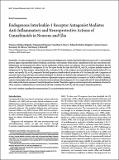Por favor, use este identificador para citar o enlazar a este item:
http://hdl.handle.net/10261/73247COMPARTIR / EXPORTAR:
 SHARE SHARE
 CORE
BASE CORE
BASE
|
|
| Visualizar otros formatos: MARC | Dublin Core | RDF | ORE | MODS | METS | DIDL | DATACITE | |

| Título: | Endogenous interleukin-1 receptor antagonist mediates anti-inflammatory and neuroprotective actions of cannabinoids in neurons and glia |
Autor: | Molina-Holgado, F. CSIC ORCID; Pinteaux, E.; Moore, J. D.; Molina-Holgado, E. CSIC ORCID; Guaza, Carmen CSIC ORCID ; Gibson, R. M.; Rothwell, Nancy J. | Fecha de publicación: | 2003 | Editor: | Society for Neuroscience | Citación: | Journal of Neuroscience 23: 6470-6474 (2003) | Resumen: | Interleukin-1 receptor antagonist (IL-1ra) is an important anti-inflammatory cytokine that blocks all known actions of IL-1 and markedly protects against experimentally induced ischemic, excitotoxic, and traumatic brain insults. Cannabinoids (CBs) also exert potent antiinflammatory and neuroprotective effects, but the mechanisms of their actions are unknown. Here we tested the hypothesis that the actions of CBs are mediated by endogenous IL-1ra. We report for the first time that both CB1 and CB2 receptors modulate release of endogenous IL-1ra from primary cultured glial cells. Activation of CB1 or CB2 receptors increased lipopolysaccharide-induced IL-1ra release, and specific CB1 or CB2 antagonists blocked lipopolysaccharide-induced production of IL-1ra from glial cells. Comparison of neuronal cultures from wild-type mice and mice lacking IL-1ra (knock-out) indicates that endogenous IL-1ra is essential for the neuroprotective effects of CBs against excessive activation of glutamate receptors (excitotoxicity) in response to S-AMPA or NMDA. Similarly, analysis of mixed glial cultures from IL-1ra knock-out mice indicates that endogenous IL-1ra is required for the CB-induced inhibition of nitric oxide production in response to bacterial lipopolysaccharide. These data suggest a novel neuroprotective mechanism of action for CBs in response to inflammatory or excitotoxic insults that is mediated by both CB1 and CB2 receptor-dependent pathways. | URI: | http://hdl.handle.net/10261/73247 | DOI: | 10.1523/JNEUROSCI.23-16-06470.2003 | ISSN: | 0270-6474 |
| Aparece en las colecciones: | (IC) Artículos |
Ficheros en este ítem:
| Fichero | Descripción | Tamaño | Formato | |
|---|---|---|---|---|
| Guaza,2003,JNeuroscience,23,6470-.pdf | 120,73 kB | Adobe PDF |  Visualizar/Abrir |
CORE Recommender
PubMed Central
Citations
53
checked on 05-abr-2024
SCOPUSTM
Citations
176
checked on 17-abr-2024
WEB OF SCIENCETM
Citations
158
checked on 24-feb-2024
Page view(s)
295
checked on 23-abr-2024
Download(s)
227
checked on 23-abr-2024
Google ScholarTM
Check
Altmetric
Altmetric
Artículos relacionados:
NOTA: Los ítems de Digital.CSIC están protegidos por copyright, con todos los derechos reservados, a menos que se indique lo contrario.
